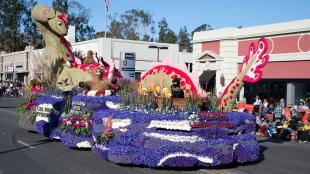'It's just a really cool experience.' What it's like to be part of Cal Poly's Rose Float team

It was an unexpectedly warm New Year’s Day in Pasadena.
Crowds cheered along Colorado Boulevard. Marching bands warmed up and parade float operators stood around the staging area on Orange Grove Boulevard, waiting for the big moment.
Connor Graves looked up at the clear sky and saw a B-2 bomber plane roar overhead.
Go time.
He raced to get into his position as animations operator on “Aquatic Aspirations,” Cal Poly’s float entry in the 2020 Tournament of Roses Parade. Walter Trygstad, the float’s driver, started it up and the float began its hourslong crawl down the famed parade route – the culmination of months of hard work.
“It’s just a really cool experience to make something that millions of people get to see,” said Graves, a fourth-year computer science major who’s worked on Cal Poly’s Rose Parade float since his freshman year. “Being inside the float was an amazing experience that not many people get to do, and it’s a huge payoff that everything’s working and we get to show it to the world.”
And this year, “Aquatic Aspirations” won the prestigious Director Award for the most outstanding artistic design and use of floral and non-floral materials.
“We’ve never won the Director Award before,” said Sidney Strong, a fourth-year industrial engineering major and president of the Cal Poly SLO Rose Float team. “I’m just so proud of our team for everything we’ve done this past year. It’s real exciting to get not only a prestigious award but one that combines multiple aspects of our program and really focuses on our success overall."
Cal Poly’s float, the only student-operated float to appear in the annual Rose Parade in Pasadena, is a cooperative effort that spans two campuses and hundreds of miles. Cal Poly students spend months completing the first half of the float, which is trucked down to Cal Poly Pomona every October.
Once that float is in Pomona, the SLO students make an approximately 400-mile round trip every weekend for the rest of the fall quarter as they continue to work on it. After finals week in December, Cal Poly students move into the Kellogg West Conference Center and Hotel on Pomona’s campus as they begin Design Week, working from 7 a.m. to midnight each day.
Right before Christmas, they move the float from Pomona to Pasadena, so it can be stored in a building near the Rose Bowl.
“That’s an overnight trip,” said Josh D’Aquisto, the Rose Float coordinator, noting that the float can’t fit on a truck at that point and has to be towed through side streets via semi-truck – with the operators inside the float, steering it through the turns. “We have to block the streets and use a police escort to get it 31 miles to Pasadena.”
Then comes Deco Week, a full-out sprint to festoon the entry with nearly 23,000 colorful blooms, mostly from the Golden State. Students work alongside volunteers to get the float decorated. And then, less than 12 hours till the start of the parade, the float requires another police escort as it drives to the staging area on Orange Grove Boulevard.
D’Aquisto said that about 200 to 250 students participate in Rose Float at some level, while the leadership team, which consists of about 30 students on each campus, make a year-round commitment and have specific responsibilities.
Graves, a member of this year’s leadership team, said he initially joined the float team with a friend majoring in electrical engineering.
“I started working closely with him on the electronics team and I started picking up a lot of electrical skills and knowledge that I wouldn’t normally get in my course load,” Graves said. “It complements what I’m learning in my computer science major, and there is a decent amount of programming involved.”

Graves said the leadership experience taught him that it’s important to budget out time and prioritize.
“You have to make sure you’re putting enough time into your studies, because that’s the most important thing,” he said.
As one of the four float operators, Graves, who was the animations operator and electrical systems lead for the float, had to stay near the float once it was moved into the staging area at 11:30 p.m. on New Year’s Eve.
“If the Tournament of Roses needs us to move it for any reason, we need to do that within 15 minutes,” Graves said, adding that at least one float operator has to stay with the float at all times.
The operators slept in shifts in their compartments, which was similar to just sleeping in a chair, Graves said. But sleep wasn’t the main agenda of the night.
“It was a big party atmosphere,” Graves said. “It’s open to the public, so there’s people walking up and down the street looking at floats, and some people from the Rose Float club came by and hung out with us, and everyone counted down at midnight.”
The best part of the experience was the parade and seeing the payoff for months of hard work and commitment, Graves said. But the project also gave him a group of tight-knit friends and hands-on experience that complemented his major – and taught him new things.
“Everything is designed and built by students and you get a lot of real-word experience in working with people and managing projects,” Graves said. “It’s a really great example of Learn by Doing."




